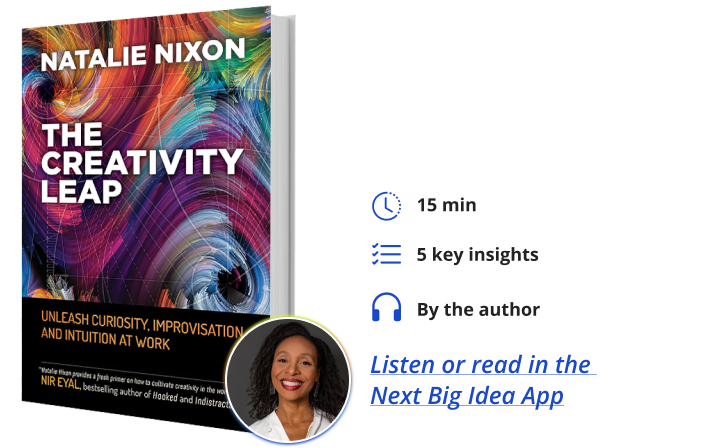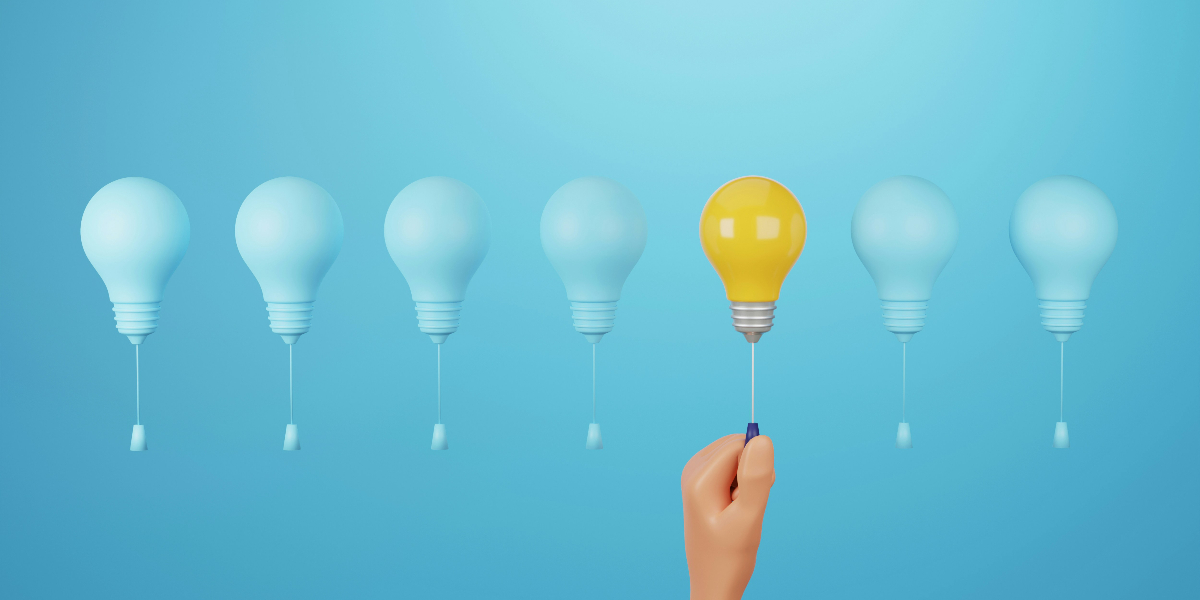Natalie Nixon is the CEO of Figure 8 Thinking and a Creativity Strategist known as “the creativity whisperer to the C-Suite.” She helps companies connect the dots between creativity and business impact through her speaking, writing, and advisory work.
Below, Natalie shares five key insights from her new book, The Creativity Leap: Unleash Curiosity, Improvisation and Intuition at Work. Listen to the audio version—read by Natalie herself—in the Next Big Idea App.

1. Toggling between wonder and rigor is a competency.
Creativity must be understood not as a rare gift possessed by an anointed, select few, but as a skill that can be cultivated and nurtured through practice. Creativity integrates wonder—the capacity to explore new possibilities through awe, dreaming, audacious curiosity, and pausing (because it is impossible to wonder when you’re going 80 mph)—and rigor—the discipline to bring these possibilities to fruition through focus, time on task, and skill mastery. Rigor is not particularly sexy and it is often a solitary venture. Wonder is found in the midst of rigor, and rigor cannot be sustained without wonder.
It’s not only individuals who can apply this toggling. Teams can too, so that organizations develop a creative competency.
If you think about creativity in this way, then you soon realize that the best coders, attorneys, CFOs, plumbers, teachers, project managers, and artists are all super creative! In The Creativity Leap, I share practical techniques for enhancing your creative skills, such as engaging in question-storming, applying lateral thinking, and embracing diverse perspectives. These practices will help you and your organization develop a robust creative competency, crucial for problem-solving and generating value in today’s fast-paced world.
2. Creativity leaps are essential.
A leap in creativity isn’t just a small step; it’s an exponential jump that bridges the gap between the current state and potential future innovations. Creativity leaps are essential because they challenge the status quo and push boundaries, allowing individuals and organizations to transition from mundane, outdated methods to vibrant, effective new strategies and innovative ideas.
“The blend of wonder and rigor involves dreaming of what could be and meticulously planning how to achieve it.”
Such leaps start with envisioning something out of reach and require the bravery to jump, despite potential barriers. The blend of wonder and rigor involves dreaming of what could be and meticulously planning how to achieve it. Wonder asks, What if?—and rigor plans and executes. Wonder fuels vision and optimism while propelling us forward; while rigor ensures that we’re grounded enough to make our leap effective and attainable.
Through real-world examples from various industries, The Creativity Leap demonstrates how fostering an environment that embraces these leaps leads to innovative breakthroughs, such as the development of new technologies or revolutionary business models. Creativity leaps require dreamy and audacious risks combined with calculated and disciplined advances for innovation.
3. Organizations need 3i Creativity to consistently create.
How does one consistently and sustainably toggle between wonder and rigor? That requires a framework I developed called the 3i Creativity™ framework: inquiry, improvisation, and intuition.
The first I is inquiry. Inquiry is about your ability to ask new, different, and better questions. This comes with practice. In an organizational environment, this means cultivating a culture that normalizes asking questions, instead of viewing asking questions as punitive.
The second I is improvisation. This is about becoming more experimental by building prototypes. Prototypes are rough draft, ugly mockups of an idea. They enable you to fail fast and early without huge investments of money or time.
The third I is intuition. Intuition is not something discussed in business school, medical school, or law school, yet every successful leader I’ve ever worked with endorses the role of their intuition. Following that inner nudge can result in incredible breakthroughs. Intuition is pattern recognition. It’s like a muscle or sonar: the more you use it, the stronger and clearer it gets. The more you ignore it the flabbier and dimmer it will become.
4. Creativity is the engine for innovation.
Innovation is nothing without creativity. In fact, creativity is the engine for innovation. I define an innovation as an invention converted into scalable value. It’s not an innovation until the invention delivers scalable social, financial, or cultural value.
How do you go from a one-off invention to a scalable innovation? If you want to consistently and sustainably innovate you must commit to building the creative capacity of yourself, those on your team, and your organization.
5. Boost your CQ.
Just as people have an IQ (a quotient of intelligence) and EQ (emotional intelligence), you also have a CQ. Your CQ is your quotient or proportion of creativity. You absolutely can cultivate, enhance, and build upon your CQ. Doing so requires a series of mindset shifts.
Visualize a series of five concentric circles. At the core, in the center circle, is gratitude. You must practice gratitude to build CQ because gratitude is the beginning of becoming a systems designer. When we are grateful for the smallest of things, we understand our interconnectivity to others. For example, take an ordinary pen that may be laying near you right now. Someone had to design the pen, engineers were responsible for the material science development, there were people and machinery at a factory who manufactured the pen, logistics experts delivered the pen to a warehouse and retailer near you. You need to be literate to use the pen and you also need money to purchase the pen. All these inputs are things for which you can be super grateful.
“When we are grateful for the smallest of things, we understand our interconnectivity to others.”
The second layer of the concentric circle is humility because once you realize all of the interrelated inputs that made that pen possible, it really helps to put yourself in perspective and become more humble about your place in the grand scheme of things.
Humility then leads to the third concentric circle of curiosity. When we are humbled, there’s no shame to our game and we have the courage to raise our hand and ask different sorts of questions. We understand that our ignorance is the beginning of discovery.
After curiosity comes the fourth concentric circle: empathy. Empathy is something that many leaders talk about as a leadership skill—and it is. But the precedent to empathy is curiosity because you cannot empathize with a soul until you’re able to ask simple questions such as, Why do they do it that way and not our way? or, Why do they sit over there and not over here?
Finally, empathy leads to action. Actions will lead us to envision and create better products, services, and experiences that enhance the world.
To listen to the audio version read by author Natalie Nixon, download the Next Big Idea App today:































